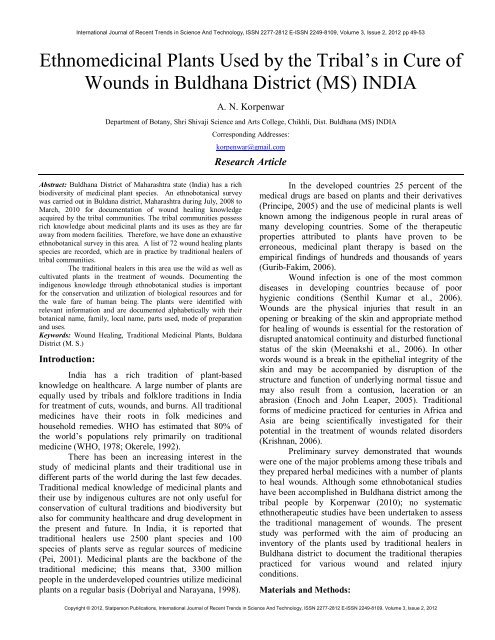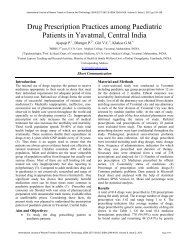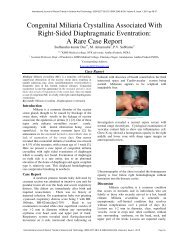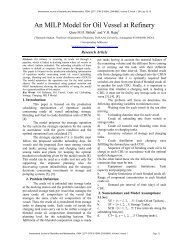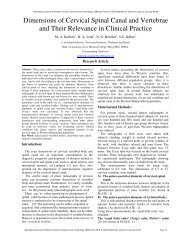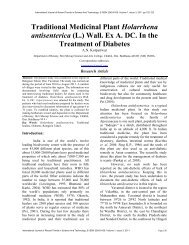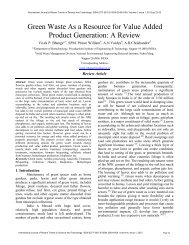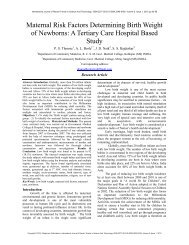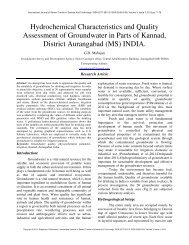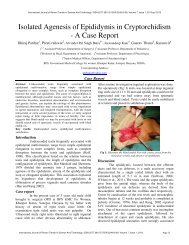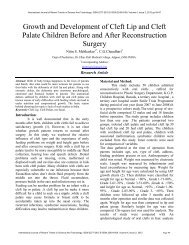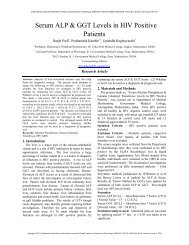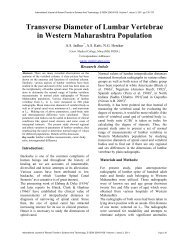Ethnomedicinal Plants Used by the Tribal's in Cure of ... - Statperson
Ethnomedicinal Plants Used by the Tribal's in Cure of ... - Statperson
Ethnomedicinal Plants Used by the Tribal's in Cure of ... - Statperson
You also want an ePaper? Increase the reach of your titles
YUMPU automatically turns print PDFs into web optimized ePapers that Google loves.
International Journal <strong>of</strong> Recent Trends <strong>in</strong> Science And Technology, ISSN 2277-2812 E-ISSN 2249-8109, Volume 3, Issue 2, 2012 pp 49-53<strong>Ethnomedic<strong>in</strong>al</strong> <strong>Plants</strong> <strong>Used</strong> <strong>by</strong> <strong>the</strong> Tribal’s <strong>in</strong> <strong>Cure</strong> <strong>of</strong>Wounds <strong>in</strong> Buldhana District (MS) INDIAA. N. KorpenwarDepartment <strong>of</strong> Botany, Shri Shivaji Science and Arts College, Chikhli, Dist. Buldhana (MS) INDIACorrespond<strong>in</strong>g Addresses:korpenwar@gmail.comResearch ArticleAbstract: Buldhana District <strong>of</strong> Maharashtra state (India) has a richbiodiversity <strong>of</strong> medic<strong>in</strong>al plant species. An ethnobotanical surveywas carried out <strong>in</strong> Buldana district, Maharashtra dur<strong>in</strong>g July, 2008 toMarch, 2010 for documentation <strong>of</strong> wound heal<strong>in</strong>g knowledgeacquired <strong>by</strong> <strong>the</strong> tribal communities. The tribal communities possessrich knowledge about medic<strong>in</strong>al plants and its uses as <strong>the</strong>y are faraway from modern facilities. Therefore, we have done an exhaustiveethnobotanical survey <strong>in</strong> this area. A list <strong>of</strong> 72 wound heal<strong>in</strong>g plantsspecies are recorded, which are <strong>in</strong> practice <strong>by</strong> traditional healers <strong>of</strong>tribal communities.The traditional healers <strong>in</strong> this area use <strong>the</strong> wild as well ascultivated plants <strong>in</strong> <strong>the</strong> treatment <strong>of</strong> wounds. Document<strong>in</strong>g <strong>the</strong><strong>in</strong>digenous knowledge through ethnobotanical studies is importantfor <strong>the</strong> conservation and utilization <strong>of</strong> biological resources and for<strong>the</strong> wale fare <strong>of</strong> human be<strong>in</strong>g. The plants were identified withrelevant <strong>in</strong>formation and are documented alphabetically with <strong>the</strong>irbotanical name, family, local name, parts used, mode <strong>of</strong> preparationand uses.Keywords: Wound Heal<strong>in</strong>g, Traditional Medic<strong>in</strong>al <strong>Plants</strong>, BuldanaDistrict (M. S.)Introduction:India has a rich tradition <strong>of</strong> plant-basedknowledge on healthcare. A large number <strong>of</strong> plants areequally used <strong>by</strong> tribals and folklore traditions <strong>in</strong> Indiafor treatment <strong>of</strong> cuts, wounds, and burns. All traditionalmedic<strong>in</strong>es have <strong>the</strong>ir roots <strong>in</strong> folk medic<strong>in</strong>es andhousehold remedies. WHO has estimated that 80% <strong>of</strong><strong>the</strong> world’s populations rely primarily on traditionalmedic<strong>in</strong>e (WHO, 1978; Okerele, 1992).There has been an <strong>in</strong>creas<strong>in</strong>g <strong>in</strong>terest <strong>in</strong> <strong>the</strong>study <strong>of</strong> medic<strong>in</strong>al plants and <strong>the</strong>ir traditional use <strong>in</strong>different parts <strong>of</strong> <strong>the</strong> world dur<strong>in</strong>g <strong>the</strong> last few decades.Traditional medical knowledge <strong>of</strong> medic<strong>in</strong>al plants and<strong>the</strong>ir use <strong>by</strong> <strong>in</strong>digenous cultures are not only useful forconservation <strong>of</strong> cultural traditions and biodiversity butalso for community healthcare and drug development <strong>in</strong><strong>the</strong> present and future. In India, it is reported thattraditional healers use 2500 plant species and 100species <strong>of</strong> plants serve as regular sources <strong>of</strong> medic<strong>in</strong>e(Pei, 2001). Medic<strong>in</strong>al plants are <strong>the</strong> backbone <strong>of</strong> <strong>the</strong>traditional medic<strong>in</strong>e; this means that, 3300 millionpeople <strong>in</strong> <strong>the</strong> underdeveloped countries utilize medic<strong>in</strong>alplants on a regular basis (Dobriyal and Narayana, 1998).In <strong>the</strong> developed countries 25 percent <strong>of</strong> <strong>the</strong>medical drugs are based on plants and <strong>the</strong>ir derivatives(Pr<strong>in</strong>cipe, 2005) and <strong>the</strong> use <strong>of</strong> medic<strong>in</strong>al plants is wellknown among <strong>the</strong> <strong>in</strong>digenous people <strong>in</strong> rural areas <strong>of</strong>many develop<strong>in</strong>g countries. Some <strong>of</strong> <strong>the</strong> <strong>the</strong>rapeuticproperties attributed to plants have proven to beerroneous, medic<strong>in</strong>al plant <strong>the</strong>rapy is based on <strong>the</strong>empirical f<strong>in</strong>d<strong>in</strong>gs <strong>of</strong> hundreds and thousands <strong>of</strong> years(Gurib-Fakim, 2006).Wound <strong>in</strong>fection is one <strong>of</strong> <strong>the</strong> most commondiseases <strong>in</strong> develop<strong>in</strong>g countries because <strong>of</strong> poorhygienic conditions (Senthil Kumar et al., 2006).Wounds are <strong>the</strong> physical <strong>in</strong>juries that result <strong>in</strong> anopen<strong>in</strong>g or break<strong>in</strong>g <strong>of</strong> <strong>the</strong> sk<strong>in</strong> and appropriate methodfor heal<strong>in</strong>g <strong>of</strong> wounds is essential for <strong>the</strong> restoration <strong>of</strong>disrupted anatomical cont<strong>in</strong>uity and disturbed functionalstatus <strong>of</strong> <strong>the</strong> sk<strong>in</strong> (Meenakshi et al., 2006). In o<strong>the</strong>rwords wound is a break <strong>in</strong> <strong>the</strong> epi<strong>the</strong>lial <strong>in</strong>tegrity <strong>of</strong> <strong>the</strong>sk<strong>in</strong> and may be accompanied <strong>by</strong> disruption <strong>of</strong> <strong>the</strong>structure and function <strong>of</strong> underly<strong>in</strong>g normal tissue andmay also result from a contusion, laceration or anabrasion (Enoch and John Leaper, 2005). Traditionalforms <strong>of</strong> medic<strong>in</strong>e practiced for centuries <strong>in</strong> Africa andAsia are be<strong>in</strong>g scientifically <strong>in</strong>vestigated for <strong>the</strong>irpotential <strong>in</strong> <strong>the</strong> treatment <strong>of</strong> wounds related disorders(Krishnan, 2006).Prelim<strong>in</strong>ary survey demonstrated that woundswere one <strong>of</strong> <strong>the</strong> major problems among <strong>the</strong>se tribals and<strong>the</strong>y prepared herbal medic<strong>in</strong>es with a number <strong>of</strong> plantsto heal wounds. Although some ethnobotanical studieshave been accomplished <strong>in</strong> Buldhana district among <strong>the</strong>tribal people <strong>by</strong> Korpenwar (2010); no systematicethno<strong>the</strong>rapeutic studies have been undertaken to assess<strong>the</strong> traditional management <strong>of</strong> wounds. The presentstudy was performed with <strong>the</strong> aim <strong>of</strong> produc<strong>in</strong>g an<strong>in</strong>ventory <strong>of</strong> <strong>the</strong> plants used <strong>by</strong> traditional healers <strong>in</strong>Buldhana district to document <strong>the</strong> traditional <strong>the</strong>rapiespracticed for various wound and related <strong>in</strong>juryconditions.Materials and Methods:Copyright © 2012, <strong>Statperson</strong> Publications, International Journal <strong>of</strong> Recent Trends <strong>in</strong> Science And Technology, ISSN 2277-2812 E-ISSN 2249-8109, Volume 3, Issue 2, 2012
A.N. KorpanwarStudy Area: (Buldhana District)Buldhana is <strong>the</strong> western most district <strong>of</strong> <strong>the</strong>Vidharbha, <strong>of</strong> <strong>the</strong> Maharashtra State. The name <strong>of</strong> townis derived from <strong>the</strong> corrupt form <strong>of</strong> Bhil-Thana i.e. <strong>the</strong>place <strong>of</strong> Bhils. The district is situated between 19°.51'and 21°.17' North latitudes and 75°.57' and 76°.49' Eastlongitudes. It is bounded on <strong>the</strong> north <strong>by</strong> Nimar district<strong>of</strong> Madhya Pradesh, on east <strong>by</strong> <strong>the</strong> Akola and Amaravatidistricts, on <strong>the</strong> west <strong>by</strong> <strong>the</strong> Jalgaon and Aurangabaddistricts and on <strong>the</strong> south <strong>by</strong> <strong>the</strong> Jalna and ParbhaniDistricts.Buldhana district has a variety <strong>of</strong> medic<strong>in</strong>alplants which are used <strong>by</strong> <strong>the</strong> tribals for <strong>the</strong>ir primaryhealthcare. In Buldhana district Bhil, Bhilala, TadviBhil, Nihal, Andh, Pardhi and banjara tribals are naturalreta<strong>in</strong>ers <strong>of</strong> traditional knowledge. Traditionalknowledge is passed from generation to generationthrough oral folklore.The field study was carried out from June 2008to December 2010 and <strong>in</strong>formation on <strong>the</strong> use <strong>of</strong>medic<strong>in</strong>al plants was obta<strong>in</strong>ed through, field tours,<strong>in</strong>terviews and <strong>in</strong>formal conversations with traditionalhealers, knowledgeable persons or medic<strong>in</strong>e men,Vaidoos, experienced and aged persons, local healers <strong>of</strong><strong>the</strong> villages. They were consulted for record<strong>in</strong>g localname; plant parts used, methods <strong>of</strong> drug preparation andrecommended doses. Personal <strong>in</strong>terviews and groupdiscussions with local <strong>in</strong>habitants revealed some veryvaluable and specific <strong>in</strong>formation about <strong>the</strong> plants.The plants were collected from remote places <strong>in</strong>vegetative and bloom<strong>in</strong>g conditions, simultaneously,not<strong>in</strong>g <strong>the</strong> vernacular names and all <strong>the</strong> relevant<strong>in</strong>formation disclosed <strong>by</strong> <strong>the</strong> local practitioners. Theplants were brought to <strong>the</strong> laboratory and processed forherbarium specimen. <strong>Plants</strong> were identified us<strong>in</strong>grelevant scientific literature (Hooker 1872 – 1877;Cooke 1967 (Rpr.); Sharma et al. 1996; Naik 1998;S<strong>in</strong>gh and Karthikeyan, 2000; S<strong>in</strong>gh et al. 2001).Subsequent visits were planned to photograph<strong>the</strong> plants <strong>in</strong> proper bloom<strong>in</strong>g period. Identifiedspecimens were deposited <strong>in</strong> <strong>the</strong> herbarium <strong>of</strong> <strong>the</strong>Botany Department, Shri Shivaji Science and ArtsCollege, Chikhli, Dist. Buldhana (M.S.).Results:The present study identified that traditionalhealers used 72 species <strong>of</strong> ethnomedic<strong>in</strong>al plantsdistributed <strong>in</strong> 66 genera belong<strong>in</strong>g to 42 families totreat wounds and related <strong>in</strong>juries. The dicotyledons arerepresented <strong>by</strong> 67 species <strong>of</strong> 40 genera and 38 familieswhile monocotyledons <strong>by</strong> 4 species <strong>of</strong> 4 genera and 3families and Pteridophytes <strong>by</strong> s<strong>in</strong>gle family with 1species (Table-1.). Of which, Acalypha <strong>in</strong>dica,Anacardium occidentale, Areca catechu, Calotropisgigantea, Cissampelos pareira, Costus speciosus,Euphorbia hirta, Ficus bengalensis, Madhucalongifolia, Mor<strong>in</strong>da citrifolia, Pongamia p<strong>in</strong>nata, andVitex negundo are commonly used <strong>by</strong> <strong>the</strong> studied tribalpeople <strong>in</strong> <strong>the</strong> heal<strong>in</strong>g <strong>of</strong> wounds and medic<strong>in</strong>alproperties <strong>of</strong> <strong>the</strong>se plants have also been provided(Table-1).Leaves were found to be <strong>the</strong> most frequentlyused plant parts account<strong>in</strong>g for 32 preparations followed<strong>by</strong> root (23), stem (14), whole plant parts (11), fruit (7),Oil and latex (3), and o<strong>the</strong>rs such as flower and rhizome.Most <strong>of</strong> <strong>the</strong> ethnobotanical studies confirmed that leavesare <strong>the</strong> major portion <strong>of</strong> <strong>the</strong> plant used for <strong>the</strong> treatment<strong>of</strong> diseases. The reason why leaves are used mostly isthat <strong>the</strong>y are easily accessible and are active <strong>in</strong>photosyn<strong>the</strong>sis and production <strong>of</strong> metabolites (Ghorbani,2005). With regard to <strong>the</strong> families with wound heal<strong>in</strong>gplants, Fabaceaeis represented <strong>by</strong> highest number <strong>of</strong>species (7) followed <strong>by</strong> Asteraceae and Euphorbiaceae(6), Mimosaceae (5) and Apocynaceae and Verbenaceae(3) and o<strong>the</strong>rs represent less than 3.Discussion:The study <strong>of</strong> herbal medic<strong>in</strong>es as <strong>the</strong>rapeuticagents <strong>of</strong> a paramount importance <strong>in</strong> address<strong>in</strong>g healthproblems <strong>of</strong> traditional communities and third worldcountries as well as <strong>in</strong>dustrialized societies (Cano andVolpato, 2004). Previous reports on <strong>the</strong> ethnobotany <strong>of</strong>are an evidence for <strong>the</strong> presence <strong>of</strong> numerousethnomedic<strong>in</strong>al plants used <strong>by</strong> <strong>the</strong> tribals (Naik 1998;S<strong>in</strong>gh et al. 2001; Sr<strong>in</strong>ivasan et. al., 2001; Reddy et. al.,2002; Olajide et. al., 2004; Mathivanan et. al., 2006; andManjunatha et al., 2007). Kumar et. al., (2007) andBiswas and Mukherjee (2003) reported that about 163species <strong>of</strong> plants were used as wound heal<strong>in</strong>g plants <strong>in</strong>Indian systems <strong>of</strong> medic<strong>in</strong>e such as Ayurveda, Siddha,Unani and folk medic<strong>in</strong>e.Accord<strong>in</strong>g to various traditional medic<strong>in</strong>alpractices throughout <strong>the</strong> world, wounds have beentreated mostly topically with different medic<strong>in</strong>al herbsor with <strong>the</strong>ir extracts solely or <strong>in</strong> comb<strong>in</strong>ation with someo<strong>the</strong>r plant parts. Tribals also prepare medic<strong>in</strong>es <strong>in</strong> acomb<strong>in</strong>ation <strong>of</strong> several plant parts and <strong>the</strong>y believe thatcomb<strong>in</strong>ation <strong>of</strong> different plant parts cures diseasesrapidly. Faced with <strong>in</strong>creas<strong>in</strong>g burden on health care,wound healers are exam<strong>in</strong><strong>in</strong>g all possible resources forsolutions.In Thailand Aloe vera gel was <strong>in</strong>cluded <strong>in</strong> <strong>the</strong>Thai Herbal Fundamental Public Health Drug List asburn and wound <strong>the</strong>rapy and several studies suggestedthat Aloe vera, or one or more <strong>of</strong> its constituentspromote wound heal<strong>in</strong>g <strong>in</strong> various animal models(Maenthaisong, 2007).International Journal <strong>of</strong> Recent Trends <strong>in</strong> Science And Technology, ISSN 2277-2812 E-ISSN 2249-8109, Volume 3, Issue 2, 2012 Page 50
International Journal <strong>of</strong> Recent Trends <strong>in</strong> Science And Technology, ISSN 2277-2812 E-ISSN 2249-8109, Volume 3, Issue 2, 2012 pp 49-53Conclusion:The present study revealed that traditionalmedic<strong>in</strong>es are still <strong>in</strong> common use <strong>by</strong> <strong>the</strong> tribalcommunities. Thus <strong>the</strong> study ascerta<strong>in</strong>s <strong>the</strong> value <strong>of</strong> agreat number <strong>of</strong> plants used <strong>in</strong> tribal medic<strong>in</strong>e especially<strong>in</strong> wound heal<strong>in</strong>g which could be <strong>of</strong> considerable<strong>in</strong>terest <strong>in</strong> <strong>the</strong> development <strong>of</strong> new drugs. There isobviously much still unknown <strong>in</strong>formation about plantsto treat various ailments <strong>in</strong>clud<strong>in</strong>g wounds. Traditionalhealers use <strong>the</strong>se medic<strong>in</strong>al plants for <strong>the</strong> treatment <strong>of</strong>wounds <strong>in</strong> <strong>the</strong>ir remote areas where modern treatmentfacilities are unavailable. Documentation <strong>of</strong> such plantsfrom <strong>the</strong> perspective <strong>of</strong> ethnobiological angle isimportant for <strong>the</strong> understand<strong>in</strong>g <strong>of</strong> <strong>in</strong>digenousknowledge systems. These resources are geneticallyimportant for future research.This study evidently po<strong>in</strong>t out that, <strong>in</strong>stead <strong>of</strong>try<strong>in</strong>g to identify <strong>the</strong> active components <strong>of</strong> herbsthrough massive collection <strong>of</strong> plants from naturalsources, it is better to start <strong>in</strong>vestigat<strong>in</strong>g <strong>the</strong> efficacy <strong>of</strong><strong>the</strong> natural product from <strong>the</strong> traditional use.Acknowledgements:The author acknowledges <strong>the</strong> assistanceextended <strong>by</strong> <strong>the</strong> tribal communities and also <strong>the</strong> forest<strong>of</strong>ficials for grant<strong>in</strong>g permission to enter <strong>the</strong> forestsdur<strong>in</strong>g field visits.References:[1] Biswas, T. K. and B. Mukherjee (2003). Plant Medic<strong>in</strong>es<strong>of</strong> Indian Orig<strong>in</strong> for Wound Heal<strong>in</strong>g Activity: A Review.Lower Extr Wounds, 2: 25–39.[2] Cano, J. H. and G. Volpato (2004). Herbal mixtures <strong>in</strong> <strong>the</strong>traditional medic<strong>in</strong>e <strong>of</strong> Eastern Cuba. J. Ethnopharmacol.,90:293-316[3] Cooke, T. (1967). (Rpr.) The Flora <strong>of</strong> <strong>the</strong> Presidency <strong>of</strong>Bombay. Vol. I, II, III. Botanical Survey <strong>of</strong> India. Culcutta.[4] Dobriyal, R. M. and D. B. A. Narayana (1998). Ayurvedicherbal raw material. The Eastern Pharmacist. 31-35.[5] Gould, J. C. and J. H. Bowie (1952). The determ<strong>in</strong>ation <strong>of</strong>bacterial sensitivity to antibiotics. Ed<strong>in</strong>b. Med. J. 59:178-199.[6] Enoch, S. and D. John Leaper (2005). Basic science <strong>of</strong>wound heal<strong>in</strong>g. Surgery 23: 37 – 42.[7] Ghorbani, A. (2005). Studies on pharmaceuticalethnobotany <strong>in</strong> <strong>the</strong> region <strong>of</strong> Turkmen Sahra, north<strong>of</strong> Iran (Part 1): general results. Journal<strong>of</strong> Ethnopharmacology, 102, 58-68.[8] Gurib-Fakim, A. (2006). Review – Medic<strong>in</strong>al plants:Traditions <strong>of</strong> Yesterday and drugs <strong>of</strong> tomorrow. Mol AspMed 27: 1- 93.[9] Hooker, J. D. (1872-1997). The Flora <strong>of</strong> British India. Vol.I – VII. London.[10] Krishnan, P. (2006). The scientific study <strong>of</strong> herbal woundheal<strong>in</strong>g <strong>the</strong>rapies: Current state <strong>of</strong> play. Curr Anaes CritCare, 17: 21–27.[11] Kumar, B., Vijayakumar, M., Gov<strong>in</strong>darajan, R., and P.Pushpangadan (2007). Ethnopharma-cological approachesto wound heal<strong>in</strong>g-Explor<strong>in</strong>g medic<strong>in</strong>al plants <strong>of</strong> India, JEthno-pharmacol 114: 103-113.[12] Maenthaisong, R., Chaiyakunapruk, N., Niruntraporn,S.and C. Kongkaew (2007). The efficacy <strong>of</strong> Aloe vera usedfor burn wound heal<strong>in</strong>g: A systematic review. Burns. 33:713-718.[13] Manjunatha, B. K., Vidya, S. M., Krishna, V., Mankani, K.L., S<strong>in</strong>gh, S.D. and Y. N. Manohara (2007). Comparativeevaluation <strong>of</strong> wound heal<strong>in</strong>g potency <strong>of</strong> Vitex trifolia L.and Vitex altissima L. Phyto<strong>the</strong>r Res 21: 457-461.[14] Mathivanan, N., Surendiran, G., Sr<strong>in</strong>ivasan, K. and K.Malarvizhi (2006). Mor<strong>in</strong>da pubescens JE Smith (Mor<strong>in</strong>dat<strong>in</strong>ctoria Roxb) fruit extract accelerates wound heal<strong>in</strong>g <strong>in</strong>rats. J Med Food 9: 591-593.[15] Meenakshi, S., Raghavan, G., Nath, V., Ajay Kuma,r S.R.and M. Shanta (2006). Antimicrobial, wound heal<strong>in</strong>g andantioxidant activity <strong>of</strong> Plagiochasma appendiculatumLehm. et L<strong>in</strong>d. J. Ethnopharmacol. 107: 67-72.[16] Naik, V. N. (1998). Marathwadyatil SamanyaVanaushhadhi. (Marathi) Amrut Prakashan, Aurangabad.[17] Okerele, O. (1992). WHO Guidel<strong>in</strong>es for <strong>the</strong> Assessment<strong>of</strong> Herbal Medic<strong>in</strong>es. Fitoterapia, 63(2), 99-110.[18] Olajide, O. A., Aderogba, M.A., Adedopa, A. D. A. and J.M. Mak<strong>in</strong>de (2004). Effects <strong>of</strong> Anacardium occidentalestem bark extract on <strong>in</strong> vivo <strong>in</strong>flammatory models. JEthnopharmacol 95: 139-142.[19] Pei, S.J. (2001). Ethnobotanical approaches <strong>of</strong> traditionalmedic<strong>in</strong>e studies: Some experiences from Asia.Pharmaceutical Biology, 39:74-79.[20] Pr<strong>in</strong>cipe, P. (2005). Monetis<strong>in</strong>g <strong>the</strong> pharmacologicalbenefits <strong>of</strong> plants. US Environmental protection Agency,Wash<strong>in</strong>gton, D.C. pp. 1991.[21] Reddy, J. S., Rao, P. R. and M. S. Reddy (2002). Woundheal<strong>in</strong>g effects <strong>of</strong> Heliotropium <strong>in</strong>di-cum, Plumbagozeylanicum and Acalypha <strong>in</strong>dica <strong>in</strong> rats. J Ethnopharmacol79: 249-251.[22] Senthil Kumar, M., Sripriya, R., Vijaya Raghavan, H. andP.Sehgal (2006). Wound Heal<strong>in</strong>g Potential <strong>of</strong> Cassiafistula on Infected Alb<strong>in</strong>o Rat Model. J Surg Res 131: 283–289.[23] Sharma, B. D., Karthikeyan, S. and N. P. S<strong>in</strong>gh. (1996).Flora <strong>of</strong> Maharashtra state,Mono-cotyledones. BotanicalSurvey <strong>of</strong> India. Calcutta.[24] S<strong>in</strong>gh, N. P. and S. Karthikeyan (2000). “Flora <strong>of</strong>Maharashtra State-Dicotyledones” Vol. I. BotanicalSurvey <strong>of</strong> India. Calcutta.[25] S<strong>in</strong>gh, N. P., Lakshm<strong>in</strong>arasimhan, P., Karthikeyan, S. andP. V. Prasanna (2001). “Flora <strong>of</strong> Maharashtra State –Dicotyledones” Vol. II. Botanical Survey <strong>of</strong> India, Calcutta[26] Sr<strong>in</strong>ivasan, K., Muruganandan, S., Lal, J., Chandra, S.,Tandan, S. K. and V. Raviprakash (2001). Evaluation <strong>of</strong>anti<strong>in</strong>flammatory activity <strong>of</strong> Pongamia p<strong>in</strong>nata leaves <strong>in</strong>rats. J Ethnopharmacol 78: 151-157.[27] Tripathi, Y. C. (2000). Ethno medic<strong>in</strong>al treasure <strong>of</strong> tribalRajasthan. J. Non-Timber for Products, 7(1- 2): 77-84.Table 1: List <strong>of</strong> Wound heal<strong>in</strong>g ethnomedic<strong>in</strong>al plants used <strong>by</strong> <strong>the</strong> tribals <strong>in</strong> Buldhana district.Copyright © 2012, <strong>Statperson</strong> Publications, International Journal <strong>of</strong> Recent Trends <strong>in</strong> Science And Technology, ISSN 2277-2812 E-ISSN 2249-8109, Volume 3, Issue 2, 2012
International Journal <strong>of</strong> Recent Trends <strong>in</strong> Science And Technology, ISSN 2277-2812 E-ISSN 2249-8109, Volume 3, Issue 2, 2012 pp 49-5362 Semecarpus anacardium L. Anacardaceae T Biba Rt, Ft63 Tagetes erecta L. Asteraceae H Zendu Fl, L64 Term<strong>in</strong>alia arjuna Bedd Combretaceae T Kahu St65 Thespesia populnea Soland ex correa Malvaceae T Parashpipul Ft, L66 Tridex Procumbens L. Asteraceae H Tantani L67 Viscum album L. Loranthaceae C Banda W68 Vitex negundo L. Verbeneceae S Nirguda L69 Xanthium stumarium L. Asteraceae S Gokhru Rt70 Z<strong>in</strong>giber <strong>of</strong>fic<strong>in</strong>ale Rosc. Z<strong>in</strong>giberaceae H Adrak Rh71 Ziziphus jujuba L. Rhamnaceae T Bor Rt, L72 Ziziphus mauritiana L. Rhamnaceae T Bor Rt(H = Herb, S = Shrub, T = Tree, C = Climber, R = Runner, L = Leaves, SD = Seed, St = Stem, Ft = Fruit, W = Whole plant, Rh = Rhizome, Rt = Root, Fl =Flower, Lx = Latex, Ol = Oil)Correspond<strong>in</strong>g AuthorDr. Anil Narayanrao KorpenwarAssociate Pr<strong>of</strong>essor, Department <strong>of</strong> BotanyShri Shivaji Science & Arts College, ChikhliDist Buldana (MS) INDIAEmail: korpenwar@gmail.comCopyright © 2012, <strong>Statperson</strong> Publications, International Journal <strong>of</strong> Recent Trends <strong>in</strong> Science And Technology, ISSN 2277-2812 E-ISSN 2249-8109, Volume 3, Issue 2, 2012


